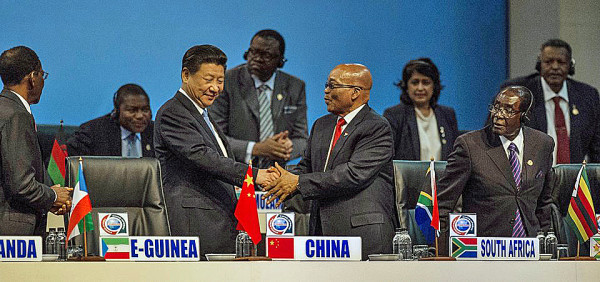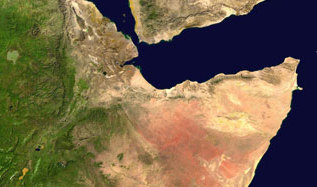PBS: Escaping Eritrea … [Read More...] about ካብ ውሽጢ ቤት ማእሰርታት ኤርትራ
5 Myths About Chinese Investment in Africa
Deborah Brautigam, 4 December 2015, Foreign Policy
Xi Jinping just announced billions of dollars worth of aid and financing for Africa. Here’s why the Chinese president is sure to be misunderstood.

JOHANNESBURG, South Africa — Santa Claus arrived early in South Africa — on a Chinese jet. This week, Chinese President Xi Jinping signed multiple business deals and brought offers of billions in new grants, loans, export credits, and investment funds as African leaders met for the sixth Forum on China-Africa Cooperation, a triennial extravaganza that showcases development and security issues of concern to Chinese and African leaders.
Not surprisingly, Xi’s second presidential visit to Africa, which also included a stop in Zimbabwe, has refocused attention on China’s expanded role on the continent. The story has dominated the airwaves and has been splashed across broadsheets around the world. But as is so often the case with China-in-Africa coverage, much of it should come with a warning label: Consume with a grain of salt. Here are five of the most dangerous — and persistent — myths about Chinese engagement in Africa that are reliably recycled by the press.
The first — and most damaging — myth is that China is in Africa only to extract natural resources. There is no question that the continent’s vast natural resource endowments are a big draw for Chinese firms — just as they are for Western oil and minerals giants like Shell, ExxonMobil, and Glencore. Yet even in oil-rich countries like Nigeria, this is far from the whole story. In 2014 alone, Chinese companies signed over $70 billion in construction contracts in Africa that will yield vital infrastructure, provide jobs, and boost the skill set of the local workforce.
Technology companies have also done much to accelerate local development. More than a decade ago, the Chinese telecom firm Huawei established its West African training school in the Nigerian capital, Abuja. Ever since, it has been honing the skills of local engineers who are rolling out the cell phone networks that underpin Africa’s telecommunications revolution. The story is the same in other sectors: Our China Africa Research Initiative team at Johns Hopkins University, which has sought to map Chinese engagement and analyze its impact, found Chinese factories in Nigeria employing Nigerians and producing building materials, light bulbs, ceramics, and steel from salvaged ships. As one Nigerian official told me in a 2009 interview, “The Chinese are trying to get involved in every sector of our economy.”
A second myth centers around the extent of Chinese involvement on the continent. Observers often dramatically overstate the scope of Chinese official finance — loans and aid — pledged to Africa and other developing countries. Granted, the Chinese are not terribly transparent about these financial flows. Whereas members of the Organisation for Economic Co-operation and Development (OECD), which consists mainly of developed states, report their annual, country-level commitments of loans and aid, the Chinese do not. Beijing does, however, publish aggregate figures every few years — and they are lower than some of the breathless reporting would suggest. Between 2010 and 2012, Chinese official aid grew rapidly, but the total over those three years came to just $14.4 billion globally.
Compare that to a 2013 Rand Corporation study that tried to estimate Chinese aid by aggregating media reports. The figure the study’s authors came up with was $189.3 billion for 2011 alone. Wonder what they counted? One media story included as a Chinese aid commitment in their study offers a particularly stark illustration of their flawed methodology: In 2010, the business publication Tendersinfo News reported that a group of Chinese businessmen signed 22 agreements worth $250 million at an Egyptian business forum. Setting aside the fact that only a tiny percentage of memorandums of understanding like this ever result in real projects, the idea that such agreements would qualify as Chinese aid commitments is absurd.
Researchers at the Japan International Cooperation Agency Research Institute made a more rigorous effort to estimate the volume of Chinese development assistance. Unlike the Rand researchers, they figured that aid should include only the types of things that China, Japan, and other donor countries classify as official development assistance — for example, grants and subsidized loans. Their estimate for Chinese aid in 2011 was a modest $4.5 billion.
Another equally surreal example of commitment inflation was the bizarre 2013 story from a Hong Kong newspaper that China had supposedly pledged $1 trillion in finance for Africa by 2025, with 70 to 80 percent of this figure coming from China’s Export-Import Bank. When the report appeared, the Chinese bank took the unusual step of posting an online denial and even reportedly threatened legal action. Yet the story continues to circulate. That the figure was in the realm of fantasy is clear: Reaching this goal would have required some $83 billion per year. Although Chinese banks are increasingly active in Africa, our Chinese loan database shows that their total financial commitments in recent years have been roughly $10 billion annually. Even this level of finance has been difficult to disburse in countries worried about rising debt. In 2014, for example, such concerns led Ghana to cancel half of a $3 billion loan facility it signed three years earlier with the China Development Bank.
A third persistent myth is that Chinese companies employ mainly their own nationals. Last July, when President Barack Obama told a group of African ambassadors in Ethiopia that “economic relationships can’t simply be about building countries’ infrastructure with foreign labor,” everyone knew he was pointing the finger at China. But was this an accurate description of Chinese business practices? In a small group of oil-rich countries with expensive construction sectors — including Algeria, Equatorial Guinea, and Angola — governments do allow Chinese construction firms to import their own workers from China. But elsewhere in Africa, the research is clear: The vast majority of employees at Chinese firms are local hires. Hong Kong-based academics Barry Sautman and Yan Hairong surveyed 400 Chinese companies operating in over 40 African countries. They found that while management and senior technical positions tended to remain Chinese, more than 80 percent of workers were local. Some companies had localized as much as 99 percent of their workforces.
Our own research in Ethiopia found that nearly 4,800 Ethiopians were employed by the Chinese firm that built Ethiopia’s urban light rail project. Another 4,000 Ethiopians worked at Huajian, a Chinese shoe factory close to the capital of Addis Ababa. In both cases, some local workers were even sent to China for management training. These practices make economic sense for Chinese companies. In order to bring workers from China, they would have to pay much higher salaries, plus pay for airfare, room, and board. There are certainly tensions around many Chinese worksites in Africa, but they tend to stem from disputes about salaries and work conditions — not whether jobs exist for locals.
A fourth myth that won’t go away is that Chinese aid and financing is itself a vehicle for securing oil concessions and mining rights. As Richard Behar wrote in a 2008 article in Fast Company, China finances “hospitals, water pipelines, dams, railways, airports, hotels, soccer stadiums, parliament buildings — nearly all of them linked, in some way, to China’s gaining access to raw materials.” The Rand Corporation study referenced above similarly suggested that China “gets an expanded supply of resource commodities expected as payback” for its aid. A 2009 Congressional Research Service report concluded: “China’s foreign aid is driven primarily by the need for natural resources.”
Yet earlier this year, a group of researchers who actually tracked Chinese aid commitments reported that natural resource acquisition did not explain the pattern. Our own database has yet to uncover a case where Chinese aid was directly swapped for a mining or oil concession. Only one well-known deal comes close to resembling this practice. In 2007, the government of the Democratic Republic of the Congo and two Chinese construction companies founded a joint venture to bring a moribund copper mine back to life. They then negotiated with China’s Export-Import Bank to secure a $6 billion commercial rate loan, guaranteeing repayment out of the future profits from the mine. The loan, which was later reduced to $3 billion, would be used to finance infrastructure built by the two Chinese companies. Even in this case, however, it was clear that the primary interest of the Chinese companies was not access to mineral riches, but finding a way to finance the infrastructure projects they wanted to build in a country with a poor credit history.
In most other cases where Chinese banks have demanded a secure flow of income to guarantee large loans in Africa, there were no Chinese-operated mines or oil wells involved. For example, Ghana secured a $562 million loan to build its Bui Dam from China’s Export-Import Bank with cocoa produced by Ghanaian farmers. In a similar vein, it secured the $3 billion loan from the China Development Bank — the one that was later halved — with oil exports from a concession that was owned by British multinational Tullow Oil and other non-Chinese partners. In the Republic of Congo, China provided a $1.5 billion oil-backed loan, but has no oil assets. Petroleum is pumped there by European firms Total and Eni.
The fifth and final myth is that China has an insatiable appetite for African land, and perhaps even a plan to send groups of Chinese peasants to grow food in Africa that will then be shipped back home. In 2012, the chief economist of the African Development Bank called China the “biggest land grabber” in Africa. One widely circulated story alleged that China had purchased half the farm land in the DRC. Others claimed that Chinese were establishing rural villages across Africa. But in a book published in November, my research team and I examined 60 stories about Chinese agricultural investments, including the one in the DRC. We spent three years doing fieldwork and conducting interviews in over a dozen countries to check the facts — and out of nearly 15 million acres that Chinese companies reportedly acquired, we found evidence of fewer than 700,000 acres. The largest existing Chinese farms were rubber, sugar, and sisal plantations. None were growing food for export to China. And while countries like Zambia now host as many as several dozen Chinese entrepreneurs who grow crops and raise chickens for local markets, we found no villages of Chinese peasants.
Myth-making like this makes it harder to focus on a number of very real problems that exist with China-Africa engagement, such as resource transparency, sustainable timber certification, and the protection of endangered species. Distracted by imaginary problems like the ones outlined above, China-U.S. cooperation on Africa has moved at a glacial pace. Moving beyond mythology might make for a slower news day as Xi wraps up his visit to South Africa, but it will help create a better informed basis for Western engagement with China — in Africa and elsewhere.
Photo credit: MUJAHID SAFODIEN / Getty Images
